
Jumping spiders are a group of spiders that constitute the family Salticidae. As of 2019, this family contained over 600 described genera and over 6000 described species, making it the largest family of spiders at 13% of all species. Jumping spiders have some of the best vision among arthropods and use it in courtship, hunting, and navigation. Although they normally move unobtrusively and fairly slowly, most species are capable of very agile jumps, notably when hunting, but sometimes in response to sudden threats or crossing long gaps. Both their book lungs and tracheal system are well-developed, and they use both systems. Jumping spiders are generally recognized by their eye pattern. All jumping spiders have four pairs of eyes, with the anterior median pair being particularly large.

Phoneutria is a genus of venomous spiders in the family Ctenidae of potential medical significance to humans. They are mainly found in northern South America, with one species in Central America. Members of the genus are commonly referred to as Brazilian wandering spiders. Other English names include armed spiders and banana spiders.

Huntsman spiders, members of the family Sparassidae, are known by this name because of their speed and mode of hunting. They are also called giant crab spiders because of their size and appearance. Larger species sometimes are referred to as wood spiders, because of their preference for woody places. In southern Africa the genus Palystes are known as rain spiders or lizard-eating spiders. Commonly they are confused with baboon spiders from the Mygalomorphae infraorder, which are not closely related.

The Agelenidae are a large family of spiders in the suborder Araneomorphae. Well-known examples include the common "grass spiders" of the genus Agelenopsis. Nearly all Agelenidae are harmless to humans, but the bite of the hobo spider may be medically significant, and some evidence suggests it might cause necrotic lesions. However, the matter remains subject to debate. The most widely accepted common name for members of the family is funnel weaver.

Orb-weaver spiders or araneids are members of the spider family Araneidae. They are the most common group of builders of spiral wheel-shaped webs often found in gardens, fields and forest. "Orb" can in English mean "circular", hence the English name of the group. Araneids have eight similar eyes, hairy or spiny legs, and no stridulating organs.

Linyphiidae is a family of very small spiders comprising 4667 described species in 618 genera worldwide. This makes Linyphiidae the second largest family of spiders after the Salticidae. The family is poorly known; new genera and species are still being discovered throughout the world. The newest such genus is Yuelushannus from China, formally described in May 2020. Because of the difficulty in identifying such tiny spiders, there are regular changes in taxonomy as species are combined or divided.
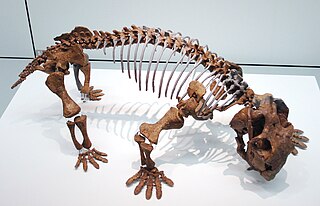
Anomodontia is an extinct group of non-mammalian therapsids containing many species from the Permian and Triassic periods, most of which were toothless, possibly endothermic herbivores. Anomodonts were very diverse during the Middle Permian, including primitive forms like Anomocephalus and Patranomodon and groups like Venyukovioidea, Dromasauria, and Dicynodontia. Of these, only the dicynodonts survived beyond the Middle Permian. Dicynodonts became the most successful and abundant of all herbivores in the Late Permian and Triassic, filling ecological niches ranging from large browsers down to small burrowers. Few dicynodont families survived the Permian–Triassic extinction event, but one lineage evolved into large, stocky forms that remained the dominant terrestrial herbivores right until the Late Triassic, when changing conditions caused them to decline.
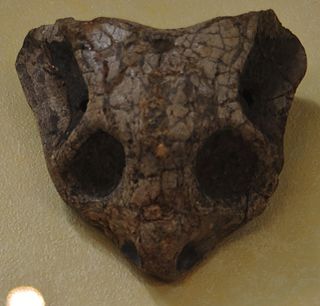
Cistecephalus is an extinct genus of dicynodont therapsid from the Late Permian of southern Africa. It was a small, specialised, burrowing dicynodont, possibly with habits similar to a modern mole. The head was flattened and wedge-shaped, the body long, and the forelimbs very strong, with similarities in structure to the forelimb of modern burrowing mammals.
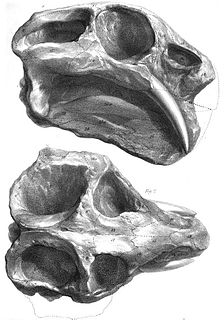
Dicynodon is a genus of dicynodont therapsid that flourished during the Upper Permian period. Like all dicynodonts, it was herbivorous. This animal was toothless, except for prominent tusks, hence the name. It probably cropped vegetation with a horny beak, much like a tortoise, while the tusks may have been used for digging up roots and tubers.
Vailimia is a genus of Asian jumping spiders that was first described by C. F. Kammerer in 2006. It was first described in 1907 from a single male about 6 millimetres (0.24 in) long. It was originally thought to be close to Harmochirus, but the male pedipalp, chelicera, and cephalothorax drawn by Proszynski in 1984, and information gained from later collected specimens indicates otherwise. Subsequently, three more species have been identified. It may be a synonym for Pancorius.

Mysmenidae is a spider family with about 135 described species in thirteen genera. The family is one of the least well known of the orb-weaving spiders because of their small size and cryptic behaviour. These spiders are found in humid habitats such as among leaf litter and in caves.
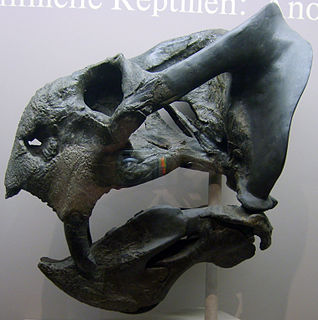
Daptocephalus is an extinct genus of non-mammalian synapsid anomodont dicynodont, it which was found in Late Permian strata, in a biozone known precisely for the presence of fossils of this dicynodont, the Daptocephalus Zone, in the Karoo Basin in South Africa. An additional species, D. huenei, is known from the Usili Formation in Tanzania and was formerly assigned to the genus Dicynodon before a study in 2019 recognised that the type specimen belonged to Daptocephalus.

Dicynodontoidea is an infraorder of dicynodont therapsids that includes the famous dicynodont Dicynodon, Lystrosaurus and the Triassic Kannemeyeriiformes, as well as numerous other closely related species. The name was coined by American paleontologist Everett C. Olson in 1941 as an infraorder, despite using the typical "-oidea" suffix of superfamilies, and was later redefined under a phylogenetic context in 2009 by paleontologist Christian F. Kammerer.
Sintocephalus is an extinct genus of dicynodont therapsid from the Late Permian of South Africa. Fossils are known from the Cistecephalus Assemblage Zone of the Beaufort Group. The type species of Sintocephalus, S. alticeps, was first named in 1913 as a species of Dicynodon. The genus was erected in 1934, but in subsequent years its species were often regarded as members of other dicynodont genera.
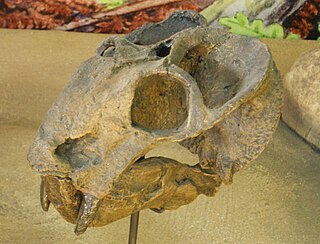
Bidentalia is a group of dicynodont therapsids. Bidentalia was one of the first names used to describe dicynodonts; the group was established in 1876, while the name "bidentals" dates back as far as 1845. With the increasing prominence of phylogenetics, the group was redefined as a clade in 2009. Bidentalia is now considered a stem-based taxon that includes all taxa more closely related to Aulacephalodon bainii and Dicynodon lacerticeps than Emydops arctatus.
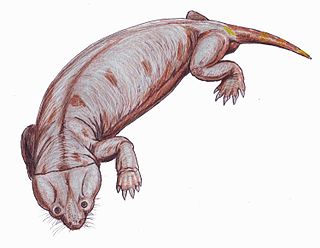
Cistecephalidae is an extinct family of dicynodont therapsids from the Late Permian of South Africa, India and Zambia. It includes the genera Cistecephalus, Cistecephaloides, and Kawingasaurus. Cistecephalids are thought to have had a fossorial or burrowing lifestyle, with adaptations such as broad skulls, strong forelimbs, and squat bodies. A similar group of dicynodonts called the pylaecephalids were also fossorial, although to a lesser extent than cistecephalids. Cistecephalids showed a high level of endemism, with each of the five known species unique to a single region.

Massetognathinae is an extinct subfamily of cynodonts in the family Traversodontidae. It includes four species from the Middle and Late Triassic: Massetognathus pascuali from Argentina, Massetognathus ochagaviae and Santacruzodon hopsoni from southern Brazil, and Dadadon isaloi from Madagascar. Massetognathines have several distinguishing characteristics, including flattened skulls, small canine teeth, and postcanine teeth with three cusps on their outer edges. Massetgognathinae was defined by Kammerer et al. (2012) as the clade containing all traversodontids more closely related to Massetognathus pascuali than to Gomphodontosuchus brasiliensis, and is the sister taxon of the traversodontid subfamily Gomphodontosuchinae, which was defined by Kammerer et al. (2008) as all traverodontids more closely related to G. brasiliensis than to M. pascuali.
Jimusaria is an extinct genus of dicynodont therapsid from the Late Permian (Changhsingian) Guodikeng Formation of China. The type species J. sinkianensis was originally named as a species of Dicynodon, the first from Asia, but was given its own genus in 1963 before being sunk back into Dicynodon in 1988. The genus was resurrected in 2011 by palaeontologist Christian Kammerer in a taxonomic revision of the genus Dicynodon. Jimusaria was a mid-sized dicynodont, and was similar in appearance to the South African Dicynodon, but differed from it in features such as its narrower snout.
Nolavia is a monotypic genus of Brazilian huntsman spiders containing the single species, Nolavia rubriventris. It was first described by C. F. Kammerer in 2006, and is found in Brazil.

Isalo II, also known as the Makay Formation, is an informal Triassic geological unit in Madagascar.















